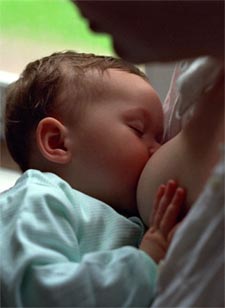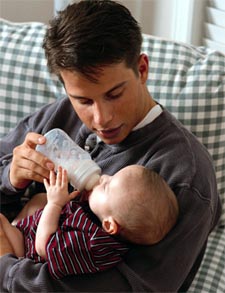Dec 17, 2025
Dec 17, 2025
by Garima Gupta
One thing that baffles most young parents is feeding their child. How much is little? How much is enough? What is normal and what is not? What is ideal ? We explore food and feeding in these series of articles designed according to the age of your child. Here, we discuss the feeding patterns and requirements of babies 0 to 12 months old.
The first few days after birth
 It is a well-established fact that the best thing for a new-born baby is mother’s milk. Science simply can’t compete with nature here. However, misunderstandings and lack of knowledge, sadly, lead many first-time mothers to believe that their milk is inadequate in either quality or quantity. They, therefore start formula milk, depriving the baby of the innumerable benefits that breast milk offers. It is absolutely essential that an expecting mother reads and learns about breastfeeding, to avoid such a thing happening to her.
It is a well-established fact that the best thing for a new-born baby is mother’s milk. Science simply can’t compete with nature here. However, misunderstandings and lack of knowledge, sadly, lead many first-time mothers to believe that their milk is inadequate in either quality or quantity. They, therefore start formula milk, depriving the baby of the innumerable benefits that breast milk offers. It is absolutely essential that an expecting mother reads and learns about breastfeeding, to avoid such a thing happening to her.
The first instances of milk that a mother produces is called colostrum. Colostrum is a thick, yellow-orange milk like liquid that is divinely good for the new-born baby. It is low in fat, and high in carbohydrates, protein, and antibodies. It is also very easy to digest, and has a laxative effect. All this increases your baby’s immunity and eases his transition from the womb to the world. Colostrum is produced very little – a few spoons at maximum. This makes new mothers worry, and they introduce supplementary milk to compensate. What they should know is that colostrum is so concentrated in nutrients that even its few drops will give your baby what he needs for his first few days.
The first few weeks
The production of breast-milk is a classic case of demand and supply. The more a baby sucks, the more milk is produced by the mother’s body. If you introduce external food during this time, the baby would suck less at mother due to less hunger. This would result in less production of breast milk. The baby would soon be hungry and irritable, and would need to be soothed by a bottle. This vicious cycle, once started, is very difficult to break. External milk is difficult to digest, low in nutrients and prone to contamination due to usage of bottles etc. If you do feel that your milk supply is insufficient to support the baby, try feeding her at shorter intervals to stimulate the production, and augment your own food and liquid intake. One more important thing that expectant mothers should learn before delivery is that even though breast-feeding is the most natural and fulfilling way to feed your new arrival, it helps if you learn the technique. The milk glands are located in the muscles of the breast and not in the nipple. Which is why the baby must suck the whole areola and not just the nipple. It is vital to ensure this, to avoid baby cutting on the nipple and hurting it.
The next two months
 In most cases, the feeding pattern is now set and the mother-baby duo are now comfortable with the feeds. This is the right time to introduce a bottle if you intend to shift the baby to the bottle after a few months any how. The baby’s mind is not so made up at this stage as it would be at age 1 year or so, and starting the bottle then to wean from the breast would be a very difficult task. Working mothers should also wait at least 2 months to start bottle, so that breast feeding is well established and is not disrupted by a bottle or two a day. A bottle a day would help you tremendously when you want to avoid breast feeding, like in a public place or if you want a 2 hour break from the house for a parlor visit, your partner can take over peacefully, with the knowledge that a bottle can be used if needed in your absence.
In most cases, the feeding pattern is now set and the mother-baby duo are now comfortable with the feeds. This is the right time to introduce a bottle if you intend to shift the baby to the bottle after a few months any how. The baby’s mind is not so made up at this stage as it would be at age 1 year or so, and starting the bottle then to wean from the breast would be a very difficult task. Working mothers should also wait at least 2 months to start bottle, so that breast feeding is well established and is not disrupted by a bottle or two a day. A bottle a day would help you tremendously when you want to avoid breast feeding, like in a public place or if you want a 2 hour break from the house for a parlor visit, your partner can take over peacefully, with the knowledge that a bottle can be used if needed in your absence.
Introducing Solids
While 4 months was considered an appropriate age to start solids earlier, now experts have revised it to 6 months of age. Remember, there is absolutely no hurry to start solids. Let the delicate tummy of your angel develop enough to withstand solids. When you do start, start with simple, easily digestible fruits, vegetable or cereals. Start with one at a time, and do not introduce new tastes and textures too soon. One new introduction a week is reasonable. While this gives the baby time to adjust to new tastes, it also gives you opportunity to see if a new food is unsuitable or irritable for your little one. Apart from commercially available cereals, consider mashed carrots, beans, daal etc. Do not go to combination food for the first few months. After the baby turns 10 months old or so, you can start combination solids-like idli, khichdi, mixed vegetables etc.
Do NOT give
Hard foods that can cause choking if swallowed whole are an absolute no till age 3 years. Some examples are : hot dogs, raw carrots, peanuts, whole grapes, popcorn, and round candies. Use your common sense and err on the safer side when in doubt.
Very soon, your baby would reach a stage when she’ll like to eat everything herself, and in the process, spill everything too. My advice at this stage would be – be patient, let the baby be – she’s only learning to use a spoon, and invest in lots of bibs and a large plastic mat. You are going to need them a lot in the second year, as we’ll see in the following article of the series.
25-Jun-2006
More by : Garima Gupta